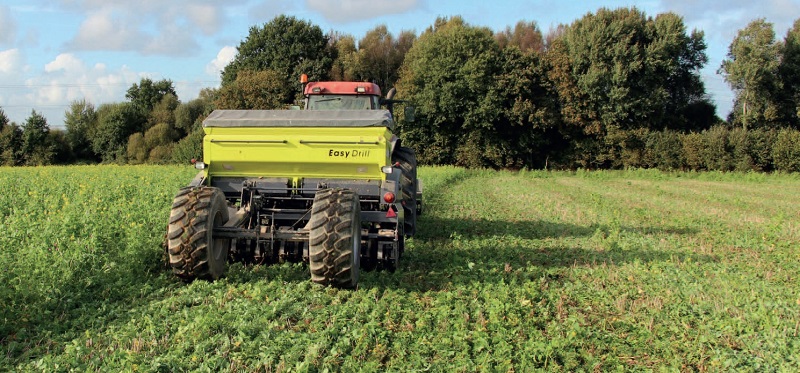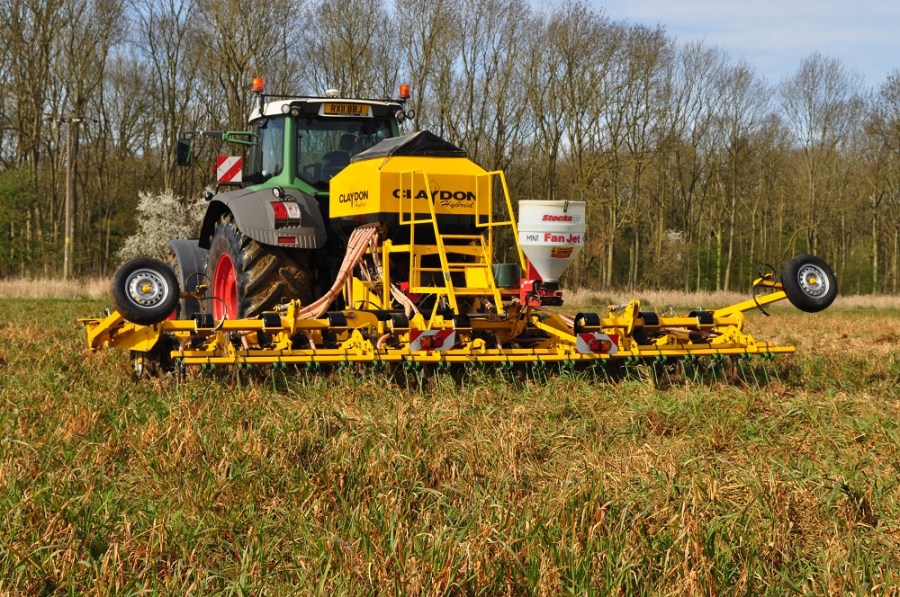The big shift to spring cropping this season is prompting drill manufacturers to adapt and develop machines to cope with working in heavier land and areas sown to cover crops, while still creating minimum seedbed disturbance. CPM reports.
Ideally the first and only cultivation should be with the drill.
By Mick Roberts
Once the preserve of lighter land, spring drilling is now increasingly coming in where blackgrass control is the priority. This means existing drills are required to perform in heavier and wetter soils in which this pernicious weed tends to thrive. At the same time wider use of cover crops is also creating a further challenge for the coulters.
Whether the land has been over-wintered as stale seedbeds or in cover crops, it’s important it’s disturbed as little as possible to keep the weed seeds buried. There is, say advisers, no point in working assiduously through the autumn to control the weeds only to bring them back up in the spring.

Work on suffering 30% seed losses or 70% plant establishment on heavy, cold soils, says Dick Neale.
“It’s important to remember why you’re spring cropping,” says Dick Neale,of Hutchinsons. “If you’re doing this to control weeds then minimal soil disturbance is a priority. Blackgrass will react to a flash of light that can induce the seed to germinate – the same applies to broadleaf weeds. Ideally the first and only cultivation should be with the drill.”
Although, he acknowledges, in general discs move less soil, some do create a fair amount of disturbance. In his experience there are also some tine coulters, such as those on the Amazone Cayena, Weaving Sabre tine and GD, which create little soil movement.
Right conditions
“It’s vital to have patience and don’t rush into drilling – wait for the conditions to be right. The soil should be friable enough to allow for good seed-to-soil contact and not too wet to leave the seed exposed,” he says.
Also be realistic with seed rates, he advises, particularly on heavier soils that has been left over winter for weed control. “Herbicides require a partnership with a good competitive crop to work well, so don’t underestimate field losses. Realistically you have to be working on 30% losses or 70% plant establishment on heavy, cold soils, which means sowing 500seeds/m² to get the 350-400 established plants/m² needed to control blackgrass effectively.”
Residual herbicides should work well when applied during the cooler, damper conditions associated with early spring drilling. “It’s vital for the pre-em application that you drill and roll in the right conditions. If you go too early and the ground is wet, there’s a risk the slot won’t close. The seed needs a covering of at least 38mm of soil to prevent damage from the pre-em,” he explains.

Some European manufacturers have gained experience in France and Germany where farmers are no longer permitted to leave land bare over winter.
Steve Corbett, trials manager at Agrii’s Throws Farm concurs, adding growers should set up the soil as far away from the drilling date as possible. “Whether that involves a stale seedbed or cover crop, it needs to be planned and implemented as soon as possible after harvest,” he says. “But if spring sowing to control weeds, it’s imperative the soil is disturbed as little as possible.
“Cover crops aren’t a miracle cure – it’s vital to choose the correct species to deliver the results you require to set up the soil for spring,” he says. “They can provide a green carpet on which to travel. In heavy land, for example, it’s important to choose a species that’ll draw moisture from the soil – so there’s no point in using something that’s killed by frost. But there’s no one simple solution.”
When it comes to sowing into cover, the drill must be able to work through the material with the coulters creating minimal disturbance, he adds. “We’ve tried a number of machines and found that plenty of existing drills – some non-specialists – that can do this if set up correctly,” he says.
Manufacturers have been quick to respond to latest requirements for spring sowing, with either new developments or adaptations to existing equipment. Väderstad’s Andrew Gamble says he’s often asked by existing Rapid users what the company offers for minimum disturbance drilling and work in cover crops.
“I reply that they already have one in the Rapid,” he says. “The Rapid with its high disc coulter pressure is already capable of direct drilling and those looking for minimum disturbance can simply lift the System Disc cultivation unit out of play.”
The Rapid is also quite capable of drilling direct into over-wintered stubble, he adds. But if soil conditions allow, it’s possible to create the seedbed in the autumn and then drill straight into this in the spring. By lifting out the cultivation elements it doesn’t disturb the soil.
“It has also been used successfully in cover crops in the spring,” he adds. “Again the System Disc needs to be lifted out, along with the track eradicators and following harrow tines, so as not to disturb the surface. If you have GPS or auto-steering, lift up the bout markers, too. It’s also possible to adjust the coulter to disc setting – with trials showing it works best in the higher position, so the disc cuts the slot with the coulter above.”
Amazone’s Cayena drill with its narrow, TineTec, coulters are designed specifically for low disturbance drilling. The coulters are also already staggered in three rows to provide 16cm spacings, with plenty of room for trash to flow through.
To further improve the suitability for spring sowing, the firm has now developed new discs to fit up front, says the firm’s Simon Brown. “These are designed for machines being used in heavier land in the spring and in cover crops. The discs run directly in front of each of the 36 coulters, with the aim to cut through the cover crop,” he explains.
Minimal disturbance
Although the discs have a ‘wavy’ edge to slice through the material, they run parallel to the direction of travel, which doesn’t disturb the soil. The discs are controlled hydraulically with collars to adjust the pressure and depth.
Great Plains is taking an interesting and novel approach to spring sowing with its new Saxon drill, which employs single discs for cutting through cover crops with minimum soil disturbance. It shares many components with the Centurion cultivator drill, which means users don’t need two drills for different conditions and seasons. It takes just a few hours to swap the cultivation discs with the Single disc units and vice versa, says David Holmes, sales director.
“We’ve been working with Agrovista and Elsom Seeds on cover crops for a few years in the UK. We’ve also gained a lot of experience in our export markets across Europe – particularly in Germany and France – where farmers are no longer permitted to leave land bare over winter and are required to sow a cover crop,” he continues.
“In the UK, more and more growers are sowing cover crops as part of their cultural control of blackgrass and to enable them to sow spring crops on heavy land. Trials using the Saxon drill show the cover crops are removing moisture from the soil, improving the friability of the soil surface and meaning the land can support traffic better in the spring.”
Slice through cover
The Saxon is fitted with a 432mm diameter Turbo Coulters, which were developed by Great Plains for its US direct drills and are designed to slice through the cover crop. The discs’ angled wave design creates ‘flutes’ that enter the soil vertically, which reduces the downward pressure needed to cut the soil. They exit parallel to the ground, which controls the soil release for minimum disturbance.
This creates a 30-50mm wide strip of tilled soil ahead of the 00 Series opener discs that place the seed in the bottom of the slot. The following closing wheel is narrow enough to run just on the tilled strip and not on the trash to help depth control.
John Deere’s 750A has gained a strong following among direct drillers in the UK. Its American roots means it was developed to cope with high levels of surface trash and, says the firm’s David Purdy, it doesn’t require any alterations for spring work or in cover crops.
“The drill is light on its feet and users comment because of this they can drill a week later in the autumn and a week earlier in the spring, with plenty of clearance around the single disc openers,” he adds.
The 457mm diameter single disc operates at an angle of 7°, which creates and cleans the slot, while the smooth-sided gauge wheel helps maintain the placement depth. The only adaptation that may be necessary in wet conditions, he adds, is to fit a recently developed spoked gauge wheel in place of the existing gauge wheel.
The seed slot is closed by a following, angled closing wheel. Some UK users replace this with a 33mm diameter Güttler Simplex Closing ring, which crumbles the soil into the slot.
A Twin Tine kit, developed by Claydon initially to improve performance in wet conditions is now proving an effective way to reduce soil disturbance and with supplementary discs to cut through cover crops, says Jeff Claydon.
“It still uses the front leading ground-breaking tine to open the slot, but instead of distributing the seed in a band with an A share, this is replaced by a two narrow seeding tines,” he explains. “These reduce the disturbance and place the seed in a 30mm band, running about 75mm either side of the seeding slot. The seed is placed in two rows and between every other one is the channel for drainage.”
Jeff Claydon recommends establishing the cover crop in the autumn with the front tine in place to provide deeper loosening and create the ‘slot’. “In the spring you can remove the front tine, because it’s done its work, and replace this with a single disc. This slices through the cover crop and the normal A share creates the ‘trench’ for the seed.
Twin tines
“The A share sows in a choice of 75mm, 125mm or 175mm bands. There’s also a 25mm wide share. Alternatively, you can also use the narrow, 12mm Twin Tines, which create minimum soil disturbance. The single discs, spaced about 150mm apart, slice through the cover and open up a passage for the tines – the ground below will have been loosened in the autumn.
Sky Drills are built in France where over-wintered cover crops are now a requirement, which is one of the main reasons why Opico identified the machines as suitable for work in UK, says managing director James Woolway.
“Key to the effectiveness of the Sky EasyDrill in cover crops is the Otico front rubber packer rollers. These flatten the material immediately in front of each pair of discs and press wheels, which makes it easier for the discs to slice through,” he explains.
He emphasises the ‘cleanness’ of the seeding line, which penetrates the soil with minimum disturbance. The discs on the coulters have a 1.5° incline and are set at a 3.5° angle to the direction of travel. A tungsten carbide skim coulter, which also works like a scraper, fitted in the shadow of the disc, cleans out the slot and places the seed. At the same time, it helps prevents hair-pinning.
The seeding coulters work in pairs, with disc depth set by the front packer roller and hydraulic weight transfer providing up to 250kg of coulter pressure.
Sky has also developed a new, large diameter roller for front-mounting to the drilling tractor. This is designed to kill off high cover crops ahead of the drill and reduce the use of glyphosate to no more than two applications/year, which again is becoming more common in France.
“For the roller, called the Faca, to be effective, however, it has to work in the right type of cover crop,” explains James Woolway. “It’s more effective in hollow-stemmed material, rather than ryegrass, for example.”
Martin Lole, founder of Mzuri, has been using a four-year rotation on his own farm, with cover crops sown prior to spring drilling in year three, which he says has combined to help eradicate the blackgrass problem the farm was facing prior to adopting strip tillage.
With the Mzuri Strip-Til, users can plant in 330mm or 660mm band widths to suit the type of crop and to capitalise on light interception that, he adds, produces a healthier and stronger crop.
Mzuri’s Select Pro-Til uses a spring-loaded pivoting disc at the front to open up the soil with minimum soil disturbance, while parting the residue to each side of the tilled strip. The disc is followed by an auto-reset tine to gently cultivate the soil where a band of fertiliser can also be placed.
Seeding accuracy
Staggered wheels then reconsolidate the tilled area, followed by ground-following coulter arms to maintain seeding accuracy. The soil is reconsolidated by a following wheel to achieve good seed-to-soil contact and levelled off by spring-loaded harrowing tines.
The recently introduced Horsch Avatar SD direct drill has two rows of single-disc coulters and its ability to exert a 200kg pressure on the discs enables it to slice through high levels of trash, says the firm’s Stephen Burcham.
Rows are spaced at 16.7cm on the 6m versions and at 20cm on the 4m and 12m wide models. The straight discs cut through the surface material ahead of the opener disc that works at a 6° angle, while a rubber coated gauge wheel controls the seeding depth.
An angled, steel press wheel, running alongside, then consolidates the soil back onto the seeding slot. A more heavy-duty version on the Pronto’s rubber suspension system is used to maintain the set pressure on the coulters.
Horsch is also currently developing new low disturbance coulters for its Sprinter drills, which will help prevent weed seeds being brought up in both the autumn and the spring, he adds.
Another alternative for low disturbance spring drilling he suggests, like other cultivator drill manufacturers, it to raise the front discs of the Pronto drill out of work, leaving just the Turbo Disc coulters to work straight into the soil. Fitting a front packer will help compress the cover crop ahead of the coulters, he adds.




